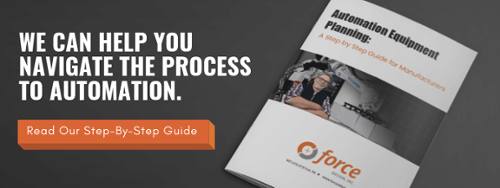Engineers have technical knowledge and an eye for detail, especially when it comes to improving a system or process. If you’ve determined that automation equipment can benefit your facility, it’s probably very clear to you how and why it’s a worthwhile investment. But the benefits and outcomes may not be as obvious to decision makers and management – the very people who approve the purchase. Because you’re the one who sees the full picture of what an automation project can accomplish, your task is much like making a sales pitch, convincing management to buy in to your solution.
From your personal experience making purchases, you know the best sales pitches are all about the buyer, not the seller. When pitching your automation project, tailor your perspective, strategy, and content to resonate with your audience of decision makers, and you’ll improve the odds of closing the deal.
Appeal to Their Perspective
Your words will always resonate most when the audience sees that you understand their perspective and when you use terms and concepts meaningful to them. It probably requires shifting your viewpoint: the primary benefits you see in one automation solution over another (or over no automation at all) won’t be as persuasive to them as they are to you and your department. For example, the details of how Vendor A’s equipment is configured and the software it uses, how it changes the steps of an existing process are all critical information to your team. But it’s too granular and removed from the bottom line for decision makers. You’re better off using a few key statistics to show the equipment will boost uptime and throughput with less waste.
“Your words will always resonate most when the audience sees that you understand their perspective and when you use terms and concepts meaningful to them.’ Tweet this.
Keep information easy to grasp, but not overly simplistic. Make sure the data used fit into the bigger picture of what’s best for your company. An executive or managerial audience is very concerned with costs (up front and ongoing), return on investment (ROI), trade-offs, and risk. Have this information at the ready, including the facts and figures that prove your case.
Consider that they probably have an agenda for the company, be it increasing production, cutting costs, expanding market share, or something else. Once you understand their agenda, you can present your project within those terms, which helps them see it as a solution and a way to accomplish their goals. If they know what’s in it for them, they’ll get behind it.
Ideally you will anticipate and address all of the key points they need to make their decision, but prepare to be interrupted with questions. Your goal is not necessarily to follow your prepared script to the letter, but to leave them with a clear understanding of how the proposed automation project fits into the factors they value most.
Plan and Practice Strategically
Decision makers and high-level managers have limited time and plenty of other tasks to juggle, so be clear and concise and get right to the point. Ways to use the allotted time to your advantage include:
- Planning to use about half of the time you’re given, which allows for questions or going over details (but only if details are requested).
- Keeping the conversation focused, but not discouraging brief questions about background or other details. Be prepared to guide discussion of tangents back to the key points if things get far off track.
- Anticipating questions they’ll have, such as:
- Can we see an ROI is less time? Can this be broken into smaller parts that will pay off sooner?
- What resources and support do you need from them? This is a good way to encourage decision makers to become personally invested.
- What are consequences if we don’t make a change/adopt automation?
- How will our competitors react to the change? How will customers react? And especially in the case of automation projects, how will our employees react?
- What is the impact of automation on our employees in terms of training/reskilling, layoffs, and hiring?
- Practicing as though it were the real thing. Go over your presentation in full and get a colleague to interject questions as you speak.
- Keeping additional information at hand so you can answer questions quickly. If you don’t have an answer ready, make a note, say you’ll provide the information afterward, and follow through.
- At the conclusion, making notes about next steps including gaps in research, questions to answer, specific concerns to address, and setting a timeline for decisions.
- Consulting your proposed automation vendor for their knowledge and experience about what works (or doesn’t) when making your pitch.
Provide Clear, Compelling Information

The documentation you provide should illustrate why your proposal is in the company’s best interest. Include sufficient facts and figures to make your case, but not so much that it’s overwhelming. It’s challenging to cut information when you’re passionate about your proposal, but try to be relentless about eliminating extraneous information.
Slides are a classic presentation tool. When designed thoughtfully, they’re an easy way to show graphs, charts, statistics, 3D conceptual renderings, and other data to everyone in the room at once. They also promote enlightening conversation and questions. To maintain focus and clarity, use as few slides as you can, fewer than 10 if possible, a large font, concise bullet points, and clear visual information help viewers grasp and digest the data with ease.
Metrics and numerical data are powerful ways to convey complex ideas, but when you have limited time, they must be meaningful and on-point. One simple way to illustrate the benefit of a change is to contrast current and projected figures. Possible figures to include:
- Overall equipment effectiveness (OEE)
- Uptime vs. downtime
- First pass yield
- Schedule/production deviation
- Throughput
- Capacity
- Takt time
- ROI
- Shop floor productivity
- Plant productivity
- Total operations productivity
- Labor cost as a percentage of revenue
“One simple way to illustrate the benefit of automation is to contrast current and projected figures.” Tweet this.
You won’t need all of these (but it’s worth calculating all of it and having it ready in case you’re asked), so select the data that best speak to their perspective and agenda.
Frame all of your facts and figures in terms that address management’s pain points, which underscores that your proposal is a solution. Keep a list of your concerns and challenges too, in case you’re asked for your perspective. Currently, many manufacturing and industrial companies are concerned with the talent shortage and/or skills gap in finding qualified workers, boosting productivity, keeping up with changing technology, and keeping legacy equipment in working order. Risk reduction is another perennial concern in terms of litigation over defective parts, worker safety and retention, growth of customer base, percentage of market share, and adaptability to market changes.
Automation is an unknown quantity for many decision makers and managers, so it can be viewed as an intimidating risk or an exciting opportunity for growth. If you do the necessary research and planning and get insight from an experienced integrator, you can present a case for automation as a viable and worthwhile change. From planning to implementation, Force Design can help. Contact us to learn more.




